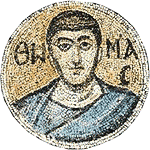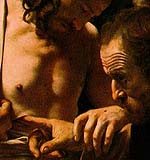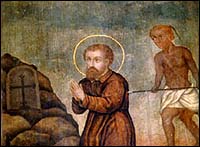 Thomas is a late bloomer, I guess. A commercial fisherman, he grew up around the Sea of Galilee. Jesus came to Capernaum, calls him, and he follows. For three years Thomas follows.
Thomas is a late bloomer, I guess. A commercial fisherman, he grew up around the Sea of Galilee. Jesus came to Capernaum, calls him, and he follows. For three years Thomas follows.
Thomas's Pessimism and Courage
But Thomas is a pessimist. Some people rejoice to see a glass half full, but Thomas sees it half empty. Oh, he's full courage, but also possesses a streak of fatalism. Once, when Jesus and his disciples hear about their friend Lazarus's death near Jerusalem, the center of Jesus' opposition, Thomas comments darkly, "Yes, let's go there that we might die with him." His words are almost prophetic.
Soon, his world falls apart. Thomas sees his Master arrested in the Garden of Gethsemane and he flees for his life. On Good Friday he watches at a distance as they spike his Friend to a cross on the Roman killing grounds of Golgotha. As Jesus' life drains away, so does Thomas's hope.
Shock and Disbelief
On Saturday he is in shock. On Sunday he is so disillusioned that he doesn't gather with his fellow disciples for an evening meal. Thomas is dazed, hurt, bitter -- and lashing out. Monday morning, the disciples go looking for Thomas and tell him what has happened in his absence.
"Thomas, we were in that upper room where we'd been meeting. We lock the doors for protection. Yet, all of a sudden, Jesus appears. 'Peace, Shalom,' he says. Then he shows us his hands. There are jagged holes where the nails had been. He pulls back his tunic and shows us where the spear penetrated his chest. But he isn't weak or sick or dying. He is alive, raised from the dead!"
Afraid to Believe
"I don't believe it," barks Thomas. "I don't believe a word of it. You're seeing what you want to see. Jesus is dead. I saw him die, and part of me died with him. But he's dead, and the sooner you accept that fact, the better off you'll be. Give it up!"
Peter pleads with him. "Thomas, I saw him myself, I tell you, and he was as real as you are!"
Thomas is cold, with an edge in his voice that cuts like ice. "Unless I see the nail marks in his hands and put my hand into his side, I will not believe it."
But Thomas's anger cools, and by the next Sunday evening he is eating with his fellow disciples in the same locked room. Suddenly, Jesus stands among them once again and speaks -- "Shalom, peace be with you."

Detail: "The Incredulity of Saint Thomas" (1601-02) by Italian artist Caravaggio (1573-1610). Click for full painting. |
All the blood drains from Thomas' face. Jesus turns to him and speaks plainly, without any hint of rancor or sarcasm, "Put your finger here, see my hands." Jesus holds out his scarred hands for him to examine. Thomas recoils. Not out of fear, really, but from a mixture of amazement and revulsion.
Jesus begins to open his outer garment and says, "Reach out your hand and put it into my side. Stop doubting and believe."
My Lord and My God
Thomas is weeping now and then begins to sob out loud. Jesus reaches out and puts a hand on his shoulder. Then Thomas slips to his knees and says in awe, "My Lord and my God!"
Thomas, "Doubting Thomas," as he is sometimes called, is the first disciple to put into words the truth that Jesus is both Lord and God. "Doubting Thomas" utters the greatest confession of faith recorded anywhere in the Bible.
Jesus replies, "Because you have seen me, you have believed. Blessed are those who have not seen and yet have believed."
Preacher in the East
What happens to him? Doubting Thomas does not stay a doubter. When he sees the risen Jesus, all that Jesus has taught over the years now clicks in, and to his death Thomas is an outspoken advocate for his Lord.
Church tradition tells us that he preaches in ancient Babylon, near the Tigris and Euphrates Rivers, where Iraq is today. He travels to Persia, present-day Iran, and continues to win disciples to the Christian faith.
 Then he sails south to Malabar on the west coast of India in 52 AD. He preaches, establishes churches, and wins to Christ high caste Brahmins, as well as others. When the Portuguese land in India in the early 1600s, they find a group of Christians there -- the Mar Thoma Church established through Thomas' preaching a millennium and a half before.
Then he sails south to Malabar on the west coast of India in 52 AD. He preaches, establishes churches, and wins to Christ high caste Brahmins, as well as others. When the Portuguese land in India in the early 1600s, they find a group of Christians there -- the Mar Thoma Church established through Thomas' preaching a millennium and a half before.
Finally, Thomas travels to the east coast of India, preaching relentlessly. He is killed near Mylapore about 72 AD, near present-day Madras. Tradition tells us that he is thrown into a pit, then pierced through with a spear thrown by a Brahmin.
He who had so fervently proclaimed his unbelief carried the Christian message of love and forgiveness to the ends of the earth in his generation.
The Doubter Speaks Today
Thomas would speak to doubters today, to those of us who have seen our hopes and dreams destroyed. Doubting Thomas would tell his story of how Jesus' life had intercepted his own. He would tell us of his fears and his doubts. And then, with a radiant, joyful face, St. Thomas, Apostle to India, would recount his joy at seeing and knowing the risen Jesus himself. "My Lord and my God!" he would say. "My Lord and my God!"
More about Thomas in
- Herbert Thurston, "St. Thomas the Apostle," Catholic Encyclopedia (1911). http://www.newadvent.org/cathen/14658b.htm
- Professor M. M. Ninan, "Story Of St. Thomas the Apostle and the St.Thomas Churhes Of India: A Short History." http://www.acns.com/~mm9n/marthoma/marthoma.htm
- William Steuart McBirnie, The Search for the Twelve Apostles (Tyndale, 1973), pp. 142-173;
- C.L. Blomberg, "Thomas," International Standard Bible Encyclopedia (Eerdmans, 1988), 4:841-842.
- "Christians of Saint Thomas," Encyclopedia Britannica.
- "Saint Thomas," Encyclopedia Britannica

 Thomas is a late bloomer, I guess. A commercial fisherman, he grew up around the Sea of Galilee. Jesus came to Capernaum, calls him, and he follows. For three years Thomas follows.
Thomas is a late bloomer, I guess. A commercial fisherman, he grew up around the Sea of Galilee. Jesus came to Capernaum, calls him, and he follows. For three years Thomas follows.

 Then he sails south to Malabar on the west coast of India in 52 AD. He preaches, establishes churches, and wins to Christ high caste Brahmins, as well as others. When the Portuguese land in India in the early 1600s, they find a group of Christians there -- the Mar Thoma Church established through Thomas' preaching a millennium and a half before.
Then he sails south to Malabar on the west coast of India in 52 AD. He preaches, establishes churches, and wins to Christ high caste Brahmins, as well as others. When the Portuguese land in India in the early 1600s, they find a group of Christians there -- the Mar Thoma Church established through Thomas' preaching a millennium and a half before.